Uncover Saint Emilion's vibrant flavors and culinary gems with our expert guides. Plan an unforgettable trip now!
Read more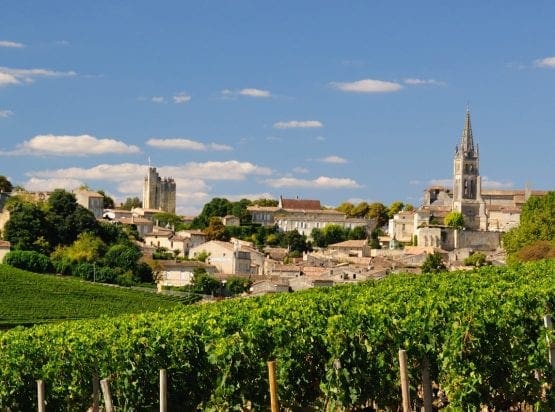
EXPLORE ALL OUR BORDEAUX WINE REGIONS GUIDE
Last updated: April 4, 2025
Fronsac and Canon Fronsac- a single zone – for all intents and purposes – represent Bordeaux at its most underrated. Situated to the west of Saint-Emilion, these Merlot-dominated red wines are among the best value in France: rich, voluptuous, and finely structured. When tasted blind, they can fool critics into believing that a particularly expensive Pomerol is being served, revealing a seductive bouquet of blackberry, damson, and mocha.
Yet, with a few notable exceptions, Fronsac and Canon-Fronsac are rarely expensive. To the naysayers who deride Bordeaux as an epicenter of overpriced wine, we invite you to explore the picturesque vineyards of Libourne.
Discover More About French Wine
Since the Gallo-Roman era, people have cultivated vineyards on the right bank of the Dordogne; centuries of conflict between the Gauls and Romans ended in 55 BC when Caesar’s legions crushed the last vestiges of the Celtic armies. During the height of Rome’s power, people planted vines along the Dordogne River and south of Bordeaux.
At the same time, skilled artisans constructed many architectural masterpieces, including an altar in the town of Fronsac, during the latter stages of the Western Empire. However, this grandiose political project collapsed in AD 476, paving the way for the ‘Dark Ages’ and endless European wars.
Post-Romans, the Franks came to power in the 5th century after the Merovingian and Carolingian dynasties ejected the Visigoths and other Germanic invaders from Gaul. Their power reached its zenith in the early 9th century after Charles Martel’s grandson, Charlemagne, was crowned Holy Roman Emperor in 800. Before that event, Charlemagne built a fortified camp on the site of modern Fronsac (Franciacus), constructed to receive the Basque duke Lupo and his offer of allegiance.
Yet during the 800s, Scandinavian Vikings raided France’s western coast, creating the duchy of Normandy. Indeed, these Norsemen (hence the moniker Normans) were fierce warriors who took no prisoners. In 849, the town of Fronsac was attacked and pillaged by a Viking chief called Hastings – the first of many incursions into Frankish territories and domains.
A Golden Age for French Wines
However, in 1152, Eleanor of Aquitaine married Henry II of England, and a third of France came under the control of the English crown. But despite the subsequent rivalry (lasting for three centuries!) between France and England, Bordeaux wine producers benefited enormously from this political union. At least, that was the situation in the vineyards of Graves – shippers granted favorable terms to the estates on the outskirts of Bordeaux.
In contrast, the first negociants marginalized the Dordogne, encouraging producers to develop an alternative commercial center in Libourne. During the Hundred Years War (1337-1453), the French suffered famous defeats at Crecy and Agincourt; trade between France and England diminished in the 15th century, and the Libournais faded into obscurity.
Cardinal Richelieu and the Resurgence of Fronsac
However, a resurgence came in the 17th century, ironically during the reign of the ineffectual and weak Louis XIII. However, Louis’ ruthless chief minister, Cardinal Richelieu, owned estates in the Dordogne, and his descendants proselytized the wines of Fronsac to the French Court.
By the 1700s, Fronsac was the most highly sought-after wine of the Right Bank, with people regarding it as vastly superior to the reds of Saint-Emilion and Pomerol! This good fortune continued until the late 19th century.
However, the phylloxera louse devastated vineyards across Bordeaux at the end of the epoch. One solution favored by wealthy landowners was to replant vines on the low-lying ‘palus’ soils, which, unfortunately, were subject to regular floods. Nevertheless, the pest could not survive in such conditions, albeit the wines made from these fertile terroirs were decidedly mediocre.
Overcoming Phylloxera and Elevating Wine Quality
Thankfully, these productive vineyards were grubbed up in the 1900s and replanted on the higher terrains, grafted onto resistant American rootstock. In 1925, growers created two syndicats: Cotes de Fronsac and Cotes de Canon-Fronsac. In 1964, the latter was granted AOC status, and the prefix ‘Cotes de’ was removed. Likewise, a law replaced the Cotes de Fronsac name with Fronsac AOC in 1976.
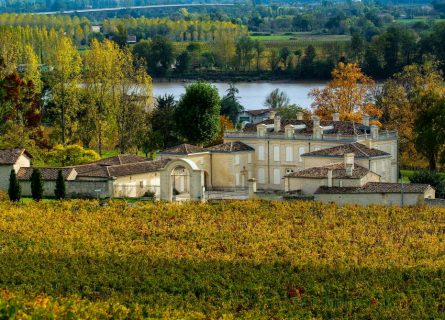
The vineyards of Fronsac and Canon-Fronsac are jewels in Bordeaux’s Right Bank, named by English merchants during its heyday in the late Middle Ages. They are located on the right bank of the Dordogne River to the east of Bordeaux city, with the River Isle serving as a natural ‘barrier’ between the zone and Pomerol to the east.
Yet despite the greater renown of its illustrious neighbor, Fronsac remains one of Bordeaux’s most captivating regions: a mosaic of dense woodland, steep valleys, rolling hills, and timeless beauty. Indeed, the pace of life is very slow here, snail-like even, which suits both locals and outsiders.
The Natural Splendor of Fronsac’s Vineyards
Today, there are approximately 771 hectares under vine in the wider region; the smaller enclave of Canon-Fronsac is found along the Dordogne River, between the towns of Fronsac and St-Michel de-Fronsac and the hills to the north of them. The slopes and plateau of the zone are rich in molasses du Fronsadais, the local term for clay-limestone soils that also contain varying degrees of sandstone.
This exceptional terroir abounds in the southern reaches of the Fronsac and Canon-Fronsac appellations, where a profusion of gentle slopes at 90 meters above sea level also ensures good drainage. Meanwhile, the proximity of two bodies of water and low elevation ensures that frost attacks are rare in Fronsac.
Diversity of Soils and Their Impact on Wine Styles
However, the zone has variances in soil and aspect despite the generous volume of limestone in the river valley. The northern section of the Fronsac appellation is rich in alluvial matter, while there is a much higher percentage of clay in the south; its depth over the limestone bedrock varies enormously, reaching three meters in some places. Thus, vines planted on sandy topsoils yield very open, fruity wines for short-term drinking.
Yet the deep bands of clay produce a style of red that resembles Pomerol: splendidly fruity in typical Right Bank manner, with plenty of tannic heft and freshness. These rich and structured Merlot blends will improve in bottle for at least a decade.
Addressing Climate Change
As elsewhere, south-facing slopes yield the most potent and voluptuous wines, with alcohol levels exceeding 15% abv occasionally. This is a point of concern for some winegrowers, who have taken steps to mitigate the most pernicious aspects of climate change.
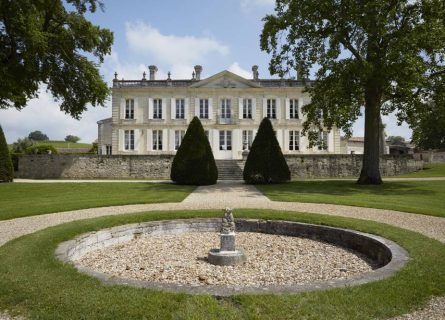
Over the past 30 years, winemaking in Fronsac has changed beyond recognition. It is a familiar story: a lack of investment and poor viticulture led to a discernible rusticity in the wines, not least caused by premature harvesting and an over-reliance on mechanization.
Moreover, there was a tendency not to destem in the 20th century, which encouraged harsh astringent tannins that would smother the fruit, matured in ancient oak barrels. These explosive monsters could, with time, evolve into velvety, complex reds after a decade of bottle age. But most consumers no longer have the patience to wait for ten years, so something had to give.
Modern Practices
Today, though, it all looks very different. As Chateau de la Dauphine and Fontenil exemplified, the modern paradigm involves plowing the vineyards and minimal use of synthetic herbicides and pesticides. At the best estates, hand-harvesting is the norm; after sorting, the grapes are crushed and then transferred to a mixture of small wooden vats and stainless steel tanks. Maceration times will vary, although most winemakers now prioritize freshness and elegance over raw power and concentration.
After fermentation, the marc is pressed in modern vertical presses as gently as possible to avoid excessive tannin pickup. After blending – Merlot typically accounts for at least 70-80 percent of the Grand Vin – the top wines are aged in new wood for at least 12 months.
A Blend of Tradition and Innovation
In most cases, it will be ‘topped up’ with a little Cabernet Franc and possibly Cabernet Sauvignon. The best results are as seductive as any Pomerol: supple, rich, and juicy on the mid-palate. A textbook Fronsac wine should offer spicy aromas, a suave texture, and ample fruit backed by firm but ripe tannins. It is also incredibly moreish – glass after glass slips down all too easily!
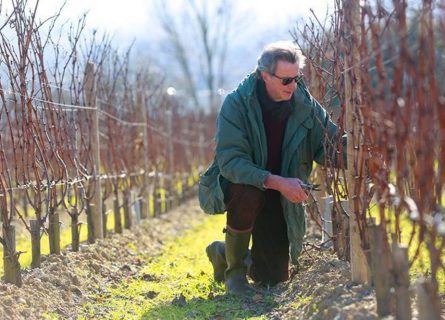
When Christian Moueix, owner of the J-P Moueix negociant firm, sold four leading Fronsac properties in 2000, the wine trade gasped. After all, these historic estates had been in the Moueix portfolio for some time; he is probably the most famous personality of the Right Bank, and his family was responsible for saving the reputation of Pomerol in the 1950s.
Nevertheless, when the supermarket tycoon Jean Halley made him an offer he couldn’t refuse, Moueix accepted. But what would become of the ailing reputation of Fronsac and Canon-Fronsac? Was this the beginning of the end, or would it herald a rebirth?
Jean Halley’s Visionary Investment
Thankfully, the latter turned out to be true. In addition to spending a small fortune on his newly acquired assets – Chateau La Dauphine, Canon de Brem, La Croix Canon, and Canon Moueix – Halley worked hard to promote Fronsac as one of Bordeaux’s best-value fine wines.
Indeed, few appellations were so badly affected by the economic crisis afflicting Bordeaux in the early 2000s as Fronsac and Canon-Fronsac. They had simply been overtaken by more trendy regions, a state of affairs exacerbated by the rush to overproduction and mechanization of the late 20th century.
A stubborn rusticity also persisted in the wines for decades, partly due to an unwise amount of Cabernet Sauvignon planted in cold clay soils; unless the vintage is exceptional, the late-ripening Cabernet needs warmer gravel terroir. Yet most of these mistakes have been corrected over the past 15 years.
Fronsac’s Renaissance
This becomes apparent when entering the cellars of Fronsac’s leading estates in 2024. You could easily be in Pomerol: the latest high-tech equipment, micro-oxygenation, malolactic fermentation in barriques, and gleaming new oak barrels produce elegant, sumptuous reds of inimitable charm. The best Fronsac-grown Merlot, enlivened with a dash of Cabernet Franc, is a delectable marriage of fruit and oak, opulence and finesse. We’ve made this point before, yet it cannot be made enough: Fronsac is Pomerol without the price tag. Snap it up.
Cabernet Franc grape is a close relative of Merlot and Cabernet Sauvignon and is the principal blending grape used in Bordeaux.
Find out moreDiscover the irresistible allure of Cabernet Sauvignon—a worldwide favorite with robust, dark-bodied flavor. Unleash your wine journey today!
Find out moreMerlot is the most cultivated grape in Bordeaux and closely related to Cabernet Franc
Find out moreThe Dordogne is a land of rolling green pastures and rich country cooking: confit de canard, andouillettes (tripe sausages), and fricassee de rognons (fried kidneys). Here, it’s all about fresh seasonal ingredients with no embellishments; local menus are often stuffed with regional dishes cooked with flair by Fronsac’s passionate chefs.
However, don’t expect a surfeit of Michelin stars, as the Dordogne is generally allergic to glitz and glamor. But family-run establishments, warm and inviting, are hard to beat.
A Gastronomy Guide to the Cuisine of Dordogne: Read more

Uncover Saint Emilion's vibrant flavors and culinary gems with our expert guides. Plan an unforgettable trip now!
Read more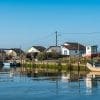
Uncover Arcachon vibrant flavors and culinary gems with our expert guides. Plan an unforgettable trip now!
Read more
Uncover Bordeaux's vibrant flavors and culinary gems with our expert guides. Plan an unforgettable trip now!
Read moreIf you would like us to customize an exclusive luxury tour, contact us and let us know your travel plans. We offer luxury food and wine tours for private groups of a mininium two guests. In addition, all of our private, chauffeured tours are available year-round upon request.

